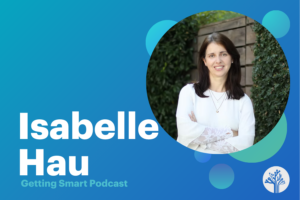The ‘Show Me’ Grading System of the Future

Three students take their single-powered speedboat on its maiden voyage out to sea. Their task: document the plastic problem through video and photo evidence. Accompanying them on the boat is all the necessary instrumentation; from microscopic lenses that fit on the back of their IPADS, to ph testing kits for measuring the acidity of the water. They compile this evidence in order to accomplish a far more challenging task: ‘Prototyping a solution.’
Back at school, a marine biologist briefs them on the harm plastic causes to sea life while an oceanographic engineer helps them sketch out robotic ‘plastic collector’ designs. Students vote on the best design and begin their build in the small maker shed. Using arduinos, sensors, small electronics and a pvc pipe/wood frame, the students ‘rapid prototype’ their design in less than two hours time.
Now it’s time to see if it works.
They grab a kiddy pool from the younger years PE department, fill it with water, and set the robot afloat. They all hold their breath, nervous for what will happen next… (See a TedTalk on this project here).
Grading the Project
What I described is a real project conducted at the Harbor School in Hong Kong. And as challenging as it was to conduct the project, it was even more challenging to award a grade.
How do you report and assess on this kind of learning? What grade should individual students receive? Clearly there was science involved; but there was also design, robotics, math, photography, and geography as well. Do students all receive a cumulative mark? Where is the place on the report card for the invaluable skills they gained in the process?
This dilemma is faced by a multitude of schools seeking to make learning more relevant in the 21st century. And while we have a plethora of new strategies for learning, from ‘STEM’ to ‘PBL’ to ‘Flipped Classroom,’ most of us still have an archaic way of grading and reporting.
‘Mastery-Based Transcript’ – A New Way of Grading and Reporting
One good example to learn from and keep an eye on is the Mastery Transcript Consortium (see their example here). Over 200 schools are developing a new way to grade and report on student work, focused on reporting on 21st-century skills and dispositions rather than subject-specific letter grades. Skills will include ‘analytical and creative thinking,’ ‘complex communication,’ and ‘digital and quantitative literacy.’ Behind each mark are links to a student portfolio of work that demonstrates growth and competence through real work samples.
And while the transcript design it is still in its relatively early stages, it has some of the innovative and well-recognized schools guiding its development, including Columbia University and High Tech High. Moreover, the time is ripe, as many innovative universities are reconsidering their admissions criteria. Goucher College, a 1,400 student liberal arts college near Baltimore, now allows students to apply through the submission of a written and visual piece of work. Bennington College, an entrepreneurial college in Vermont has completely done away with the traditional HS transcript, instead asking students to apply through a portfolio of work samples. Goucher and Bennington’s approaches are detailed here. Some other colleges have done away with grades completely, instead electing to award credits based on conversations and narratives of learning by both professor and student. All of Delaware’s colleges and universities have agreed to accept and support competency-based transcripts.
How you can get started with alternative grading and student portfolio development
Changing how we measure and report learning can seem like a daunting and unobtainable task, but given the right process it can be far easier than it sounds. If you are reading this article, it means you are probably an ‘out of the box’ thinker who doesn’t shy away from a valuable challenge just because it’s particularly daunting, so I hope you’ll bear with me.
It can also help to think of this as merely an extension of reporting and assessing on what you already do well–the following (relatively) simple five step process will help you take a step in the right direction.
Step #1: Determine skills, dispositions and habits of mind for school graduates
Like any good planning, it’s important to start with the end in mind. What are the skills, dispositions, and habits of mind you expect graduates of your school to leave your school with? If you already have a ‘graduate profile,’ start there, if not, meet together with different members/ stakeholders of your school (perhaps over coffee) and brainstorm a list using post-it notes, markers and butcher paper.
These ‘big picture’ skills should have the ability to transcend all subjects.
After you finish the brainstorm, condense, combine and categorize your list to 5-8 comprehensive skills. For sample skills, check here (21st Century Skills), here (Mastery Transcript), and here (World Global Economic Forum).
Step #2: Establish ‘I can’ statements and assessment rubrics for each skill
Now that you have identified the skills that graduates of your program/grade should possess, it’s time to articulate those skills through concrete ‘I can’ statements. These statements should be student-friendly, use accessible language, and clearly define the aim for learning. Here are some examples:
‘Leadership and Teamwork:’
- I can facilitate group discussions, help groups reach consensus, and delegate responsibilities
- I can work with a variety of stakeholders including parents, students, adults and experts in order to meet project goals
These clearly articulated statements will help provide a context for portfolio building and allow both the teacher and student to reflect on their overall growth.
Step #3: Choose an Edtech platform for digital portfolio building
It’s important that you complete this step only after you have completed the two steps above. Doing so will ensure you have a portfolio building system that matches your hoped outcomes for student learning. It is in these portfolios that students will upload work, post reflections, and provide evidence of growth in the pre-identified skills from steps one and two. I suggest using a system that is most comfortable and adaptable for use at your school. Below is a list of some good places to start:
- SeeSaw: This comprehensive portfolio builder allows you to post and share media-rich assignments, make comments on student work, create and upload work to pre-designated folders, and post to individual blogs. Information can be also be shared with parents with a simple password.
- WordPress/Weebly/SquareSpace: These easy to use blogging and website builder tools (WordPress is the free option of the bunch) allow students to create a written and visual footprint of their work throughout their school. The upside of these platforms over SeeSaw is that they give students more creative license in how they put things together. The downside is that it can be a bit messy if you don’t establish clear parameters. I suggest creating guidelines around design and #hashtags or sub-pages according to the skills you wish students to show evidence for.
- Google Docs/Drive: This is an easy, no thrills way for students to start compiling and organizing their work. Students can upload work to shared folders that match each skill identified in step #1. Work can include written, audio, and visual examples.
- Microsoft OneDrive: Similar to Google Docs, this cloud-based system allows for student and teacher to both upload work to a portfolio either through ‘notebook’ or shared folders. I like the ‘digital notebook’ interface, as it keeps everything nice and tidy, and allows for quick access.
Step #4: Determine minimum requirements and provide time for reflection and goal setting
Putting a portfolio system in place will not automatically ensure it is effective. Only through regular and meaningful reflection will portfolios demonstrate clear learning and growth. I suggest establishing a set time- either weekly or bi-weekly for work upload, student reflection and self-assessment. During this time, ensure that students:
- Review work completed for the week
- Choose 1-2 pieces of work to upload to portfolio
- Identify how the pieces of work demonstrate pre-identified skills
- Create a written or audio reflection of learning
- Check in with teacher/ facilitator to establish follow up learning goals
I suggest keeping track of student reflection and goal setting through a simple excel spreadsheet. This will help provide guidance for follow-up conversations and demonstration of growth towards those goals.
Step #5: Create/ Find models
I cannot overstress the importance of finding effective student portfolios to use as models. Effective models will help you and students create expectations and guidelines around their own. You can start by creating an example as a staff, or consider using structures from the examples below:
Student Example #1: A portfolio organized the school’s expectations for student learning.
Student Example #2: A portfolio organized around school subjects.
Student Example #3: A portfolio organized around different student projects.
In Closing
Changing the way we grade, report and evaluate student learning can oftentimes feel like an uphill battle. We are fighting against tradition, a tightly regulated bureaucracy, and educational structures that are slow to change; but our students deserve better. They deserve an evaluation system that honors their hard work and growth, regardless of how well they performed on the SATs. Implementing a mastery-based transcript, coupled with a cumulative portfolio of their learning, can even be a step in laying the foundation for more equitable access to high-quality learning experiences. To make this shift as an educator, remember to work backwards, starting with a graduate profile, and then developing self-assessment systems and rubrics for what constitutes mastery. Doing so will provide you and your team with a roadmap with which to move forward. Finally, consider joining the mastery transcript movement of like-minded educators here. To your success!
For more, see:
- Model Schools, Districts, Networks and States for Competency-Based Ed
- 12 Onramps for Personalized and Competency-based Learning
- Show What You Know: The Shift to Competency
Stay in-the-know with all things EdTech and innovations in learning by signing up to receive our weekly newsletter, Smart Update.







Debi long
I feel assessing with an open mind is the way to go . Assessment can reflect the skill in many ways.
Debi Long
I'm excited to see the various ways to assess. I love the creative thinking to show mastery in the subject area. Great ideas for a seasoned teacher.
Debi Long
I'm sold on new assessments. I'm starting portfolio. For 1st grade a great idea.
Teknik Informatika
What challenges might the students face while documenting the plastic problem at sea?